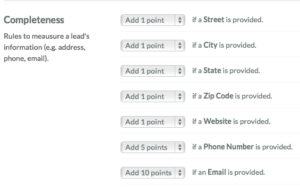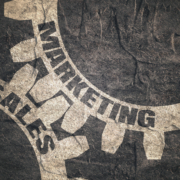7 Attributes of a Lead Scoring Model
Every company will have different ways of measuring a qualified lead, yet there is a set of factors that you can use to map into a lead-scoring model. Many marketing automation solutions, such as Eloqua, Marketo, Hubspot, Pardot, ShaprSpring, and others, have built-in lead scoring algorithms and pass this information into a CRM system like Salesforce and SugarCRM.
These scores can be set up to deliver marketing-qualified leads based on certain criteria and scores, helping sales teams accept the leads (Sales Accepted Leads) and focus their energies on the top prospects.
Marketing Automation and CRM are both important. We use Sharpspring technology for our small business retainer services to deliver inbound marketing programs and integrated marketing. Sharpspring includes an integrated CRM as well as API hooks into leading CRMs so it is great for small businesses. The life of the lead is a great way to see the flow of the lead through time and the lead scoring approach helps sales focus immediately on the top inbound leads.
The following attributes can help you determine the lead scoring model:
- Demographics – Who is the prospect? Factors include title, job function, firmographics (geography, industry, company size/number of employees, existing client, prospect from a different division within a client organization, known target prospect (active sales prospect). Be careful not to overly restrict your leads by filtering out demographics. Quite often demographics will require a sales interaction.
- Buyer Journey Where is the buyer on the buying life cycle? (Is the buyer seeking General information, product information, pricing information, “how to buy” information, a Contact Rep/ RFP request, or premium content download?) This can be mapped based on the user’s visit to selected pages or completion of selected forms.
- Behaviors and activities: How the visitor engages over time, such as the volume of email opens, website clicks, forms, events, etc., can be mapped to increase lead scores as the user engages with the brand.
- Areas of interest Determine the areas of interest to drive up or down the lead score. You can use negative points if the visitor is indicating non-buying actions. Which web pages were visited? How many?
- Value of pages High-value pages like Contact Us, pricing, RFQs, etc, should drive up the lead score.
- Activity clusters If you see visits from multiple people at one company, this could also drive up the lead score. Measure who visits the site within a certain amount of time.
- Lead Decay It is smart to reduce the score as the lead ages with no sales response. Use negative scores for emails received opened, but not clicked? How many emails have you received but not opened? How long have they been in the system? (# soft bounces?) Also, remove known “non-prospects”? (internal users, testers, analysts and consultants, competitors)
What do you do with the lead score?
Marketing should not control the decision for sales engagement. A collaborative ‘decision support’ approach works best. We recommend establishing a lead scoring model and let sales determine call priorities. Sales teams know best when there are active sales situations that may not be fully reflected in lead scores. Sales can further qualify the opportunity with BANT and Scotsman methodologies or the Revenue Architects’ FACT model – Fit, Alignment, Competition, Timeline.
Contact us to learn more.










Leave a Reply
Want to join the discussion?Feel free to contribute!